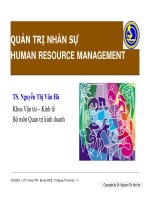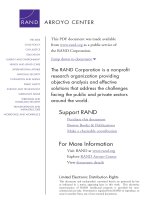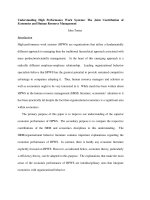HUman resource managemenr 2e s keiman chapter10
Bạn đang xem bản rút gọn của tài liệu. Xem và tải ngay bản đầy đủ của tài liệu tại đây (152.78 KB, 37 trang )
Chapter 10
Implementing Productivity
Improvement Programs
© 2010 Cengage Learning. Atomic Dog is a trademark used herein under license. All rights reserved.
Chapter Outline
•
10-1 Gaining Competitive Advantage
•
10-2 HRM Issues and Practices
•
10-3 The Manager’s Guide
© 2010 Cengage Learning. Atomic Dog is a trademark used herein under license. All rights reserved.
10-1a Opening Case: Gaining Competitive
Advantage at Lincoln Electric
•
Problem: Figuring out how to motivate employees.
•
Solution: Implement an employee incentive system.
•
Pay by the piece
Provide year-end bonuses and stock options
How the incentive system enhanced competitive
advantage
Low turnover rate.
Productivity rates two to three times greater than
competitors.
Stable price structure despite high salaries.
© 2010 Cengage Learning. Atomic Dog is a trademark used herein under license. All rights reserved.
10-1b Linking Productivity Improvement
Programs to Competitive Advantage
•
The goal of productivity improvement programs is to
improve productivity by increasing employee
motivation.
Extrinsic rewards: given by the employer to
employees.
Intrinsic rewards: those that come from within a
person.
•
Successful productivity improvement programs are
able to establish a clear connection between
employee efforts and rewards.
•
Many theories attempt to explain the motivational
process.
© 2010 Cengage Learning. Atomic Dog is a trademark used herein under license. All rights reserved.
Figure 10-1 The Expectancy Theory
Model
© 2010 Cengage Learning. Atomic Dog is a trademark used herein under license. All rights reserved.
10-2 HRM Issues and Practices
•
Pay-for-performance programs
Link financial rewards to successful job performance.
Provide extrinsic rewards.
Can create legal problems when administered unfairly.
© 2010 Cengage Learning. Atomic Dog is a trademark used herein under license. All rights reserved.
© 2010 Cengage Learning. Atomic Dog is a trademark used herein under license. All rights reserved.
10-2a Pay-for-Performance Programs
(cont.)
•
Merit pay plans
•
Grant employees annual pay raises based on their
levels of job performance.
The merit pay guidechart shows the size of a merit pay
raise associated with each level of job performance.
Merit pay plan—strengths
Established effort-performance and performance–
reward link.
Publicized merit pay guidecharts to strengthen the
performance–reward link.
© 2010 Cengage Learning. Atomic Dog is a trademark used herein under license. All rights reserved.
10-2a Pay-for-Performance Programs
(cont.)
•
Merit pay plan—weaknesses
Fail to establish a clear performance-reward link.
Fails when employees do not value the rewards
offered by the company.
Hinder performance-reward link when supervisors fail
to distinguish between employees within the team
Time lag exists between behavior and reward.
Is not very cost-efficient.
Productivity hinders if these plans fail to reward
behaviors that contribute to organizational goals.
© 2010 Cengage Learning. Atomic Dog is a trademark used herein under license. All rights reserved.
10-2a Pay-for-Performance Programs
(cont.)
•
Recommendations for properly designing and
implementing an effective merit pay plan:
Make objective assessments of employees’ job
performance.
Measure an employee’s performance on the basis of
job behaviors that have a proven impact on the
success of the business.
Make payouts quarterly, not annually.
Frequently communicate performance expectations to
employees.
Train managers to properly implement the system.
© 2010 Cengage Learning. Atomic Dog is a trademark used herein under license. All rights reserved.
10-2a Pay-for-Performance Programs
(cont.)
•
Piece rate plans
Base an individual’s wages on the number of “pieces”
or product units he or she produces.
Piece rate plans vary.
-
Straight piecework: pays workers a set amount for each
unit produced.
Different piece rates: depends on whether the worker
has met the standard.
© 2010 Cengage Learning. Atomic Dog is a trademark used herein under license. All rights reserved.
10-2a Pay-for-Performance Programs
(cont.)
•
Piece rate plans
• Strengths
• Weaknesses
Pressure placed on
Cost efficient.
employees to produce.
Employees know what to
Workers may resist
do to earn reward.
management’s attempts to
introduce new technology or
Performance standards
systems.
are objective.
Workers are not rewarded for
Rewards are tied directly
suggesting new ideas.
to performance.
Employees may neglect
aspects not covered in the
performance goals.
Encourage competition
rather than teamwork.
© 2010 Cengage Learning. Atomic Dog is a trademark used herein under license. All rights reserved.
10-2a Pay-for-Performance Programs
(cont.)
•
Gainsharing plans offer employees a cash award for
meeting or exceeding goals based on the
collaborative performance of a team of employees.
•
Most gainsharing plans feature the following:
The organization has productivity goals that can be
achieved through effective teamwork.
Employees receive cash bonuses if goals are met.
Productivity is measured by an explicit formula with
objective measures.
Employees are encouraged to submit suggestions for
cutting production costs or increasing productivity.
© 2010 Cengage Learning. Atomic Dog is a trademark used herein under license. All rights reserved.
10-2a Pay-for-Performance Programs
(cont.)
•
The Scanlon Plan
Is a gainsharing plan.
Aims to cut production costs, relative to output.
For implementing a Scanlon Plan:
-
Calculate the ratio of production cost/sales value of
production that would be expected in a typical year.
Decide how production costs are to be cut.
Allocates bonuses in the following manner: 75 percent is
paid out and 25 percent is held in reserve for lean
periods in which there are no bonuses.
© 2010 Cengage Learning. Atomic Dog is a trademark used herein under license. All rights reserved.
10-2a Pay-for-Performance Programs
(cont.)
•
Gainsharing plans
• Strengths
Effort-performance and
performance-reward links
are strong.
Link performance with the
organization’s mission.
Promote teamwork.
Are cost-effective.
• Weaknesses
Employees may perceive
rewards as being unfairly
distributed.
Employee suggestions for
improving efficiency may
dwindle over time.
May suffer if payout
formulas are inflexible.
© 2010 Cengage Learning. Atomic Dog is a trademark used herein under license. All rights reserved.
10-2a Pay-for-Performance Programs
(cont.)
•
Gainsharing programs are most likely to succeed
under the following conditions:
Management must orient the company culture to one
of respect, cooperation, and open communication.
Plan must be designed so that the payout is
dependent on factors the employee can control.
Management must meet regularly with employees to
share information and ideas and gather information.
© 2010 Cengage Learning. Atomic Dog is a trademark used herein under license. All rights reserved.
10-2a Pay-for-Performance Programs
(cont.)
•
Profit-sharing plans
Reward group, rather than individual, performance.
The payout is based on profits rather than gains.
A portion of the company’s profits is contributed to
individual employee accounts.
© 2010 Cengage Learning. Atomic Dog is a trademark used herein under license. All rights reserved.
10-2a Pay-for-Performance Programs
(cont.)
•
Three types of profit-sharing plans:
Deferred plans: An individual’s profit-sharing earnings
are distributed at retirement.
Distribution plans: The company fully distributes each
period’s earnings as soon as the profit-sharing pool is
calculated.
Combination plans: Employees receive a portion of
each period’s earnings immediately; the remainder
awaits future distribution.
© 2010 Cengage Learning. Atomic Dog is a trademark used herein under license. All rights reserved.
10-2a Pay-for-Performance Programs
(cont.)
•
Provisions included in most profit-sharing plans
•
Eligibility requirements
•
Vesting schedule
•
Employer contribution
•
Withdrawal provisions
•
Allocating profits
•
Loan provisions
•
Investment options
•
Distribution
•
Employee contribution
© 2010 Cengage Learning. Atomic Dog is a trademark used herein under license. All rights reserved.
10-2a Pay-for-Performance Programs
(cont.)
•
Profit-sharing plans
• Strengths
Improves productivity by
making employees’
interests compatible with
employers’ goals.
Employees may gain a
greater sense of
ownership.
• Weaknesses
Only marginally address
effort-performancerewards links.
Not always cost efficient.
Rewards are not timely.
© 2010 Cengage Learning. Atomic Dog is a trademark used herein under license. All rights reserved.
10-2b Employee Empowerment Programs
•
Employee empowerment gives employees greater
voice in decisions about work-related matters.
•
Empowerment can enhance productivity in two ways:
Strengthens motivation by providing employees with
the opportunity to attain intrinsic rewards from their
work.
Decisions are better because they are made by
employees, who have a more complete knowledge of
their work than do their managers.
© 2010 Cengage Learning. Atomic Dog is a trademark used herein under license. All rights reserved.
10-2b Employee Empowerment Programs
(cont.)
•
Informal participative decision-making programs
Managers and subordinates make joint decisions on a
day-to-day basis.
Have a positive impact on productivity.
The success of the program hinges on whether
employees want to participate in decision making.
© 2010 Cengage Learning. Atomic Dog is a trademark used herein under license. All rights reserved.
10-2b Employee Empowerment Programs
(cont.)
•
Job enrichment
Aims to redesign jobs to be more intrinsically
rewarding.
Characteristics that make a job intrinsically rewarding
are skill variety, task identity, task significance,
autonomy, and job feedback.
Some specific techniques for enriching a job:
-
Combine tasks
Establish client relationships
Reduce direct supervision
Increase identification with product/service
© 2010 Cengage Learning. Atomic Dog is a trademark used herein under license. All rights reserved.
10-2b Employee Empowerment Programs
(cont.)
•
Job enrichment
• Strengths
Makes jobs less
automated, and more
interesting and
rewarding.
Enrichment leads to
improvements in
productivity, quality,
absenteeism rates, and
retention.
• Weaknesses
Production may become
less efficient.
Employees preferring
highly automated jobs may
oppose job enrichment
efforts.
© 2010 Cengage Learning. Atomic Dog is a trademark used herein under license. All rights reserved.
10-2b Employee Empowerment Programs
(cont.)
•
Quality circles
A group of 6 to 12 employees who identify and resolve
production problems within their unit.
Usually meet once a week.
Are led by a coordinator who may be a supervisor
within the work group or a member elected by the
group.
© 2010 Cengage Learning. Atomic Dog is a trademark used herein under license. All rights reserved.




![audio engineering 101 [electronic resource] a beginner's guide to music production](https://media.store123doc.com/images/document/14/y/ii/medium_iij1401381447.jpg)
![broken markets [electronic resource] a user's guide to the post-finance economy](https://media.store123doc.com/images/document/14/y/kz/medium_kzd1401381668.jpg)
![ios sdk programming [electronic resource] a beginner's guide](https://media.store123doc.com/images/document/14/y/ph/medium_phw1401472929.jpg)


